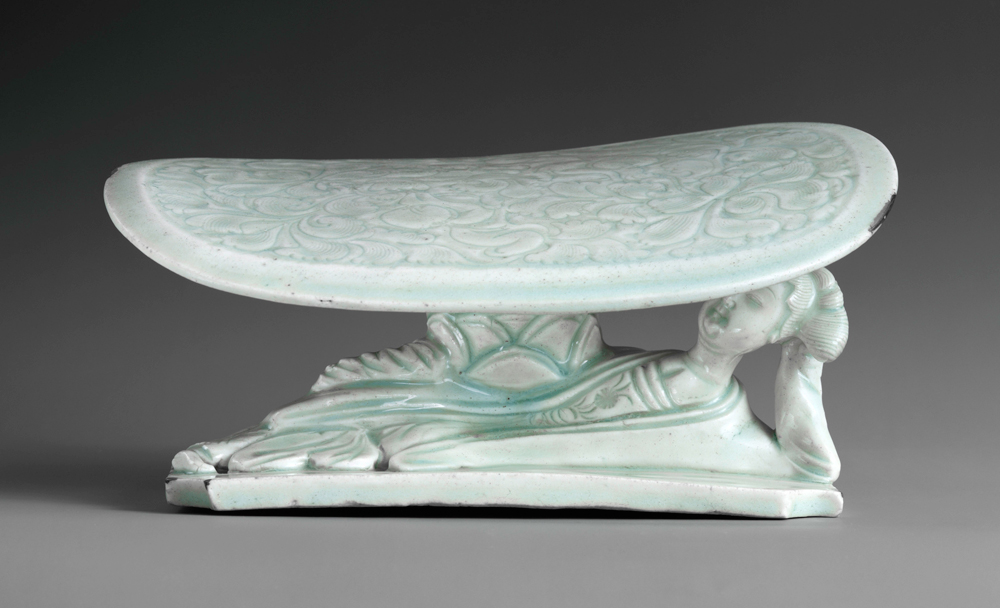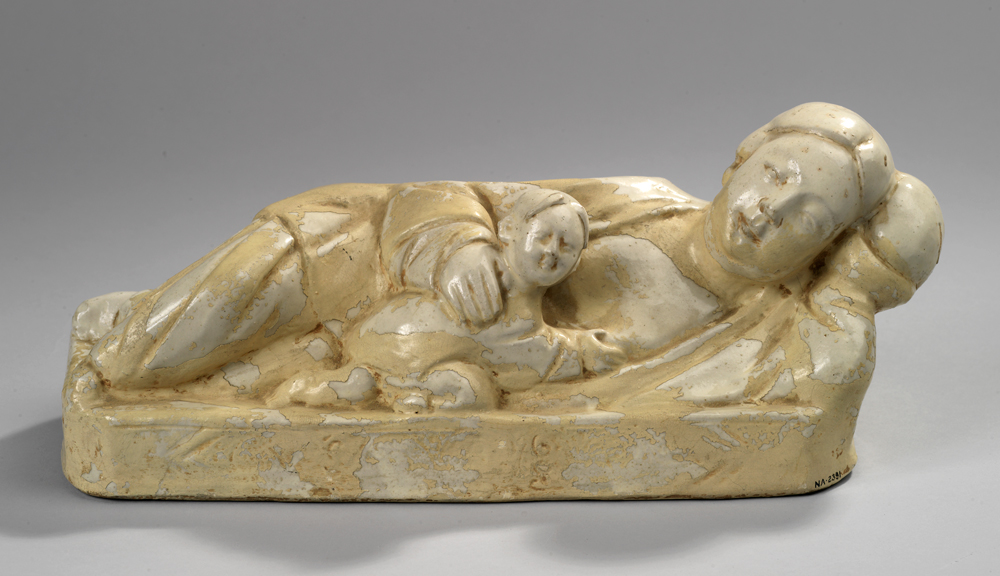Abstract
Chinese ceramic pillows are certainly very different in form to their Western equivalents. Seemingly straightforward in function, this type of object has been easily overlooked by art and design historians. This essay analyses the social value and multiple functions of ceramic pillows in Ming dynasty China, in relation to a pillow in the V&A collections.

Introduction
An unusual Chinese ceramic pillow from the collections of the Victoria and Albert Museum (V&A) serves as the focus of this essay. Produced in the Ming dynasty (1368–1644), between 1450 and 1550, this pillow is made of a fahua-type ware (fig. 1). It has been moulded into the shape of a woman reclining on a rectangular base and a small concave headrest rises from her waist as a separate part of the object. The female figure is lying on her side and directly under her head is a miniature cylindrical pillow. She wears a headdress, necklace, bracelets and earrings and holds a small dog under one arm. Her robe is tied high at the waist with cord and attached to this is a rectangular object which could be a fan. The base, face and hands are unglazed, but the eyes have been painted in black after firing. The colour palette of amber, deep purple and blue is typical of fahua wares, which were produced extensively in the provinces of Shanxi and Jiangxi between the fourteenth and sixteenth centuries.1 This ware was made using a distinctive technique. Lead fluxed glazes were painted directly onto the fired body, omitting the usual colourless porcelain glaze. Enamels were held in place through use of surface divisions; in this case the surface has been incised. A short-cut, this method of production is similar to that used for cloisonné enamel wares and is consequently known as the “enamel-on-biscuit” technique.2 Fahua wares were produced for, and consumed by, wealthy rather than imperial buyers and there is no evidence that they were made for export. Items were generally utilitarian; this type of ware was commonly used for architectural pieces like roof tiles, though other large-scale items such as vases are typical.
This ceramic pillow was bought by the Museum in 1911 from dealers S. M. Franck & Co., an importer of goods from the Near and Far East during this period. Regular dealings with this firm had been conducted since 1883.3 The acquisition files indicate that large numbers of objects were being dug up from graves as a result of newly-built railway lines in China in the early years of the twentieth century.4 Chinese burial wares, which were previously unknown in the West, were unearthed and removed by foreign engineers such as Johan Gunnar Andersson (1874–1960).5 Collectors and museums in Britain began to acquire these wares through dealers. It therefore seems likely that these were the circumstances in which this object was found. According to archaeological evidence, ceramic pillows are still commonly retrieved from tombs.6 As a result, it was previously assumed in Western scholarship that pillows were used only within the grave. Probably perceived to be uncomfortable, the need to lie relatively still upon a ceramic pillow made the argument for tomb use logical. Historian Robert Paine argued against this and suggested over fifty years ago that it is, above all, the subject matter of pillows which firmly established their original use for the living.7 Indeed, a pillow played a significant role in both environments; it is even possible that they were consciously manufactured for both. The high volume of pillows found in tombs is the principle reason for their preservation and high survival rate; there are many examples of Chinese ceramic pillows in museums worldwide today.
First manufactured in the Tang dynasty (618–907), ceramic pillows became a familiar and popular domestic item for the middle to upper classes of Chinese society by the Ming dynasty. Despite this, relatively little is known about their function within this society and they have been curiously neglected by historians. A lack of primary sources connected to this type of object has led to varied speculation about their original use.8 As a result, the existing secondary literature on ceramic pillows concentrates heavily on aesthetics and the physical qualities that relate each pillow to a certain kiln or method of production. In contrast, this essay investigates the possible uses and social values of ceramic pillows in the Ming dynasty, in relation to the pillow held in the Victoria and Albert Museum collection (hereafter the “V&A pillow”). It draws on sources such as literature, illustrations, examples of contemporary discourse on the living environment, as well as other examples of material culture. While these forms of evidence cannot be said to be representative of Ming dynasty society at large, they can be used to tentatively place a ceramic pillow in context. As an object used during sleep, the pillow’s mere functionality associates it with the bedroom. This space was separated from the domestic environment at large by its function, the material culture which furnished it and the people who used it. The V&A pillow will be analysed within this context, in order to understand what kind of meanings it may have had as an object placed and used in this room. The symbolism and iconography of the female form represented on this pillow will be closely considered to further link it to this space, and in order to generate an argument that it would have been viewed as an object connected to personal and familial concerns. Although different in date, comparisons with other similarly-shaped pillows provide further insights into the purpose of this type of object. Indeed, a pillow might even be regarded as an object which was designed to affect the environment around it.
A rest for the head
Pillows made from fahua-type wares are relatively unusual. The vast majority of surviving pillows are made of cizhouware, several of which are used as comparative examples in this essay. This was a type of sturdy stoneware produced in various kilns throughout the northern provinces of Hebei, Henan and Shaanxi, largely in the Song dynasty (960–1276), but continued into the early Ming dyansty.9 Cizhouwares were usually decorated with a creamy coloured base and iron-based line patterns.10 Though distinctly different to fahua, it is clear that pillows were regularly made from more popular and utilitarian ceramic wares, rather than those that were more expensive. Unlike the V&A pillow, the vast majority of these objects were made of a box-shape with flat surfaces on which the decoration was painted.11 Indeed, there are only a few known examples of ceramic pillows in the shape of a woman reclining. This design seemingly indicates how the object itself should be used; it is a rest for the head while a person was lying or sleeping. The shape of the rest protruding from the base of the V&A pillow is small and concave, and does seem to be suitable for a head. Such a small surface area implies that the sleeper would have to remain relatively still. At 15.9 cm, the height of this pillow meant that the head rested upon it in a semi-upward position. Unglazed and roughly painted at the back, the V&A pillow was clearly meant to face the front. It was perhaps designed to fit into another structure such as a bed or coffin, thus hiding the back of the object and providing more stability.
In physical qualities, a Chinese ceramic pillow is certainly dissimilar to its equivalent in the West. Perhaps they were used to encourage a better sleeping position for the body, or to maintain the highly complex hairstyles worn by women during the Ming dynasty.12 Contemporary literature certainly suggests that these objects had a function beyond that of the simply supportive. Guides to elegant living were popularly printed in the latter part of the Ming dynasty and provide an insight into which objects were thought necessary for an upper-class lifestyle. GaoLian was the author of one such guide, the Zun sheng bajian (Eight Discourses on the Art of Elegant Living), which was published in 1591. In it, he stated that, ‘porcelain may be used to make pillows… It has power to brighten the eyes and benefit the pupils’.13 In this case, the material qualities of ceramics were thought to have health benefits for the sleeper. According to the same source, pillows might have another effect on the user. The Immortal Yao used three scrolls with significant writings piled-up to make a pillow and, ‘thereby he dreamed pure and elegant dreams’.14 Despite the difference in material, this extract shows that pillows were thought to influence and guide dreams. This was made possible by virtue of the object’s close proximity to the head. Dreams were perceived in China to have significant meaning; often they were taken as omens, and dream interpretation was customary.15 Extensive research by Joseph Needham has shown that there was no sharp dichotomy in the division between the two states of spirit and matter in Chinese popular thought.16 Ghosts, spirits and visions in dreams were part of the material world and deemed to be interchangeable with life. Thus the pillow could be a material object of great importance, which mediated between the conscious and unconscious, between reality and the illusionary. The use and placement of a pillow within the Chinese domestic environment, as well as the people who might have used it, must be carefully considered.
The ‘inner’ sphere
As an object used primarily for sleeping, the natural setting of a pillow was a bedroom. In Ming dynasty China, domestic space was divided according to gender, and the bedroom was where women spent the majority of their time. The structure of the Chinese house was governed by ideas about proper social relations, which stemmed from Confucian ideology. Domestic space was structured in order to facilitate hierarchal relationships based on age, status and gender. The Yang Zhongmin gong yibi (Final Instructions),a letter written by Shandong province official Yang Jisheng (1516–1555) to his wife, was widely circulated in the Ming dynasty as a ‘model for managing family life’.17 An extract from this text can be used to demonstrate the prescribed segregation of space:
As for day-to-day life at home, the most important thing is that the boundaries between inner and outer must be kept with strictness and vigilance. Girls above the age of ten sui must not be allowed to pass out of the central door. Boys above the age of ten must not be allowed to enter the central door. Women from outside**[the family], even the closest relatives, must not be allowed to be visiting all the time. Partly this is to avoid gossip that leads to disharmony in the family; partly it is to avoid having them become the go-betweens for licentiousness and thievery.18
Although it is impossible to know the extent to which such tenets were enforced, this text gives a good indication of the strict ideal of gender segregation between the “inner” (nei) and “outer” (wai) spheres within the house. Women rarely left the house, let alone entered the front part of it. Only men of the family had free access to the women’s quarters, where they went to sleep at night with a wife or concubine.
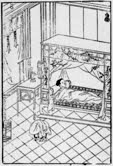
In the popular late Ming dynasty novel, Jin ping mei (The Plum in the Golden Vase), the protagonist’s first four wives reside in the rear compound of the house. Each has a bedroom, in the centre of which is a canopy bed.19 Indeed, Ming dynasty literature and illustrations regularly represent the canopy bed and the bedroom as the locus of the female apartment and of femininity itself (fig. 2). Historian Sarah Handler suggests that, ‘just as the desk was the focal point of a man’s studio, the bed was at the centre of a woman’s bedroom’.20 The bed was a space in which the women gathered or sat alone to work, eat or pursue leisurely activities such as reading, writing, sewing or playing music. In wealthy families the bed formed part of a bride’s dowry and was paraded along the streets on the way to the groom’s house, in order to demonstrate her family’s wealth and possessions. Once in place at her new home, it stood as a symbol of the woman’s position as a legitimate partner of the master. Other objects that came in a bride’s dowry were bedcovers and curtains, other furniture, clothes and make-up. These were usually the property of the woman while she remained in the household and furnished her apartment.21 As an integral part of the furnishings of a bed, it seems possible that a pillow could be part of the dowry. Thus the bed itself was certainly an object that was associated with women. This strong link can be demonstrated by scholar and author Li Yu (1611-c.1680), who wrote that, ‘if wives and concubines are the human counterparts of beds, beds are the inanimate counterparts of wives and concubines’.22 Even if this part of the house was used by men during the night, it was primarily a focus for feminine concerns.
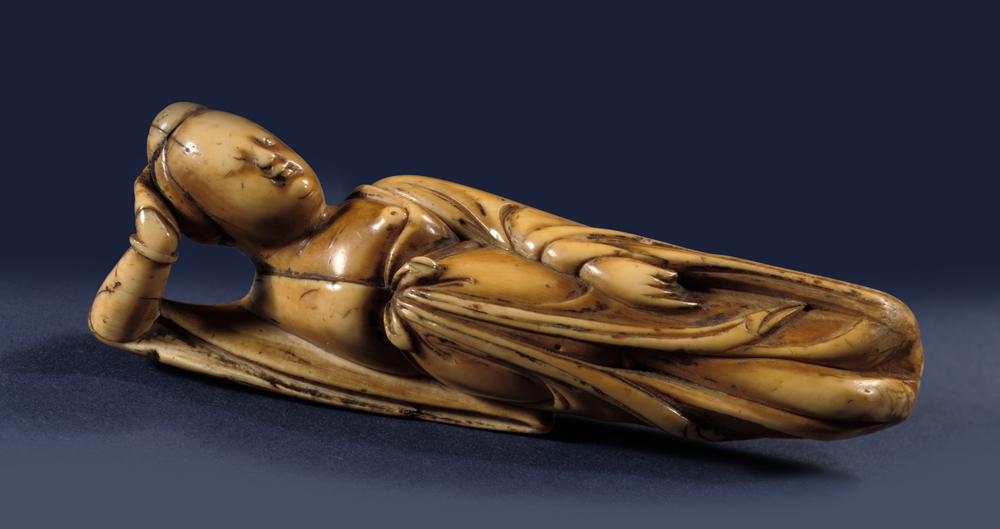
Modelled as a woman lying on her side, the form and iconography of the V&A pillow is certainly associated with femininity. This imagery provides insight into the separate roles of men and women in Ming dynasty China. A man is rarely represented lying down; his role is active, and common domestic portrayals are situated at the scholar’s desk, meeting and discussing politics and philosophy with friends, eating and drinking. Symptomatic of this is the absence of pillows in the shape of a man reclining, which demonstrates that this is an iconography more familiar to women (fig. 2). This imagery is surprisingly similar to small ivory carvings of female figures, produced in China from the Ming dynasty until the nineteenth century (fig. 3). The function of these items has been hotly debated by historians; once thought to be a medicinal aid, they are more likely to be erotic toys.23 It was recorded by Ming scholar ShenDefu (1578–1642) that ivory carvers, ‘made small figures of pairs in sexual congress which were of the highest artistic quality’.24 These figurines were produced for the local market but gained notoriety for their popularity among foreign sailors. Historian Craig Clunas has argued that representations of females were frequently linked to pleasure, ‘as the object of male regard, as the locus of fantasies about interiority and access to hidden places, as the passive bodies in a discourse of the erotic’.25 It is possible, therefore, that the V&A pillow was intended as an erotic image. The representation of a woman lying down would have been readily installed within this imagined language of sexuality. Perhaps such imagery was also used within the bedroom as an indication of how to behave and how to act. Certainly, few objects would be more suitably located for delivering this type of message.
Erotic literature was widely circulated in Ming dynasty upper-class society.26 The bed and its furnishings formed part of the discourse of romance and erotica that was centred around a woman’s room. Sarah Handler states that, ‘sexual encounters usually took place in the women’s private quarters. Thus novels and their illustrations, as well as erotic paintings, tend to depict the women’s part of the house’.27 A poem written by concubine ShenCai (b. 1752), from Zhejiang province (Jiangnan), demonstrates the centrality of the bedroom as the presumed location of sexual and romantic relations:
On pillows designed with mandarin ducks, calls of “little darling”,
As songwriters of love we truly have passion.
We sing again the melody of Fish Playing in Spring Water,
Keeping the perfumer lit and candles trimmed until dawn.28
Historian Grace Fong describes this piece as, ‘replete with conventional images of sensuality and romance, the poems reproduce the scene of the lovers ensconced in the warm intimacy of the boudoir’.29 The poem also demonstrates that a pillow was a key object within this environment. As mandarin ducks mate for life, they were a common symbol of happy matrimony in China. Thus they were a popular motif for wedding presents and decoration for the bedroom.30 This iconography is used to allude to romance in the poem and also within the bedroom itself. Clearly, the symbolic and visual messages of a pillow could be important; perhaps they were used as a prompt, or indeed a focus of discussion.
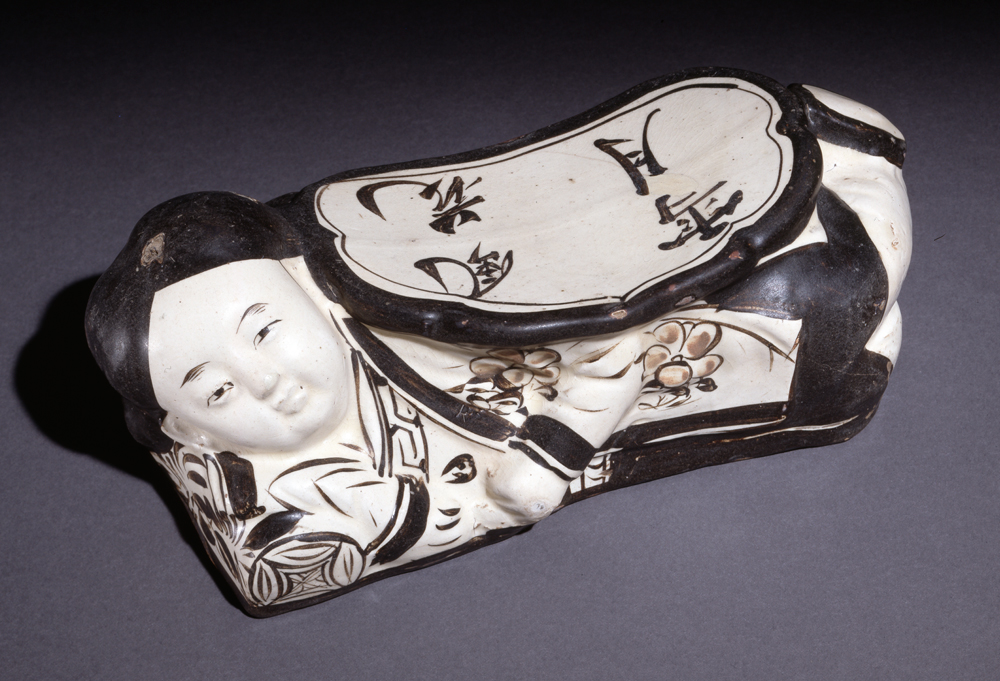
A cizhou pillow in the British Museum, made between 1115 and 1234 (fig. 4), appears to demonstrate this. It is decorated with an inscription of a poem, which has been painted on the concave part of the pillow on which the head rests. Although of a simpler form than the V&A pillow, this object has also been modelled in the form of a reclining woman, who rests her head above a miniature circular pillow. The inscription, alluding to romance, reads, ‘The wind rustles flowers under a snow white moon’.31 Certainly it is possible to imagine that such a poem was meant to be read and discussed. Perhaps to abate the feeling of discomfort imagined by using a hard pillow, Western scholars have in the past suggested that they were wrapped and padded with cloth.32 Evidence of this has been found in the form of a miniature canopy bed excavated from a Ming dynasty tomb dated to 1613, which belonged to a high official by the name of Wang Xijue in Suzhou. The bed was found equipped with a pillow in a peony-patterned satin cover, and quilts and bed curtains with similar patterns.33 Unfortunately textiles do not generally survive well, and so further evidence of pillow coverings is scarce. It seems unlikely, however, that some pillows were covered, as the decoration was clearly meant to be seen and appreciated. Certainly this is the case with the V&A pillow; covering it would make the form and decoration almost obsolete. It is of course possible that pillows were wrapped only for sleep and unwrapped for view at any other point.
Another cizhou ceramic pillow from the British Museum has been decorated with a design which was clearly meant to be seen and understood by those who used it. Made in the thirteenth century, it illustrates the story of Wang Zhaojun, a Han dynasty princess who was married to a nomad from the north-west of China for political reasons (fig. 5). Although she did not want to marry this man, she obeyed her parents’ wish. This popular story of filial piety was well known in the Ming dynasty and exemplified the typical situation of arranged marriage in Chinese culture.34 In looking at this pillow, the occupant of the bedroom might be forcibly reminded of parental obligation, which outweighed any personal feelings in matrimony. The visual nature of these messages would be particularly significant for women, as levels of female literacy were relatively low. In this case, ‘non-verbal methods of presenting to a woman paradigms of behaviour and expressions of cultural norms deemed appropriate to a subordinate position assume much greater importance’.35 Domestic marital themes such as this would thus be entirely appropriate for the bedroom, as a visual reminder of the female role in Chinese family and society.

Other examples of pillows in the form of women reclining can be related to the theme of procreation. A pillow made of Qingbai ware and produced between the twelfth and thirteenth centuries, belongs to the Metropolitan Museum of Art (fig. 6). The headrest is much larger than that of the V&A pillow and is incised with a design of two boys crawling amongst peony sprays.36 Male children were a common decorative motif which referred to the typical Chinese family wish for successive male heirs. Another example, made of ting ware and produced in the Song dynasty, can be found in the Royal Ontario Museum (fig. 7). It has been badly damaged, but art historian Helen Fernald has suggested that it did at one point support a headrest.37 The modelled female figure is breast-feeding a child, which is a clear reference to the nurturing, maternal role of women. She rests her head on a miniature pillow while she does this, demonstrating the use of a pillow during the activities of the women’s quarter. Though rare, these extant pillows in the form of women reclining have a similar theme of romance, sexual union and family. This sets a clear precedent, providing strong evidence that the V&A pillow may be similar in this regard. Such decoration may have been intended as a prompt for the production of male children, especially considering the object’s mediatory role between illusion and reality through dreams. An extract from volume 34 of the Tang dynasty commentary Tang shu (History of the Tang) stated that a younger sister of the Empress Wei used one pillow in the shape of a leopard’s head, 'in order to ward off evil influences’ and another with an image of a bear on it, 'in order to insure the birth of sons’.38 Symbolism was clearly an important decorative device, which conveyed good wishes and even mediated wish fulfilment.
Other furnishings of the bed, as well as the bed itself, were often generously ornamented with auspicious symbols relating to family and procreation. Canopy beds were sometimes carved with cloud, dragon, peony, plum blossom or peach motifs. All were suitable for the bedroom and to these messages: plum blossoms have implications of sexual pleasure and imply the presence of pretty women; clouds suggest ‘cloud and rain’, which is a euphemism for sexual union; the dragon is an emblem of male vigour and fertility.39 The bed would often be hung with curtains or surrounded by a screen that also displayed context-specific symbols and certain meanings. A bed hanging from the V&A’s collection is a good example of such an object; made between 1800 and 1900, this silk embroidered cloth is patterned with a theme of boys (fig. 8).40 Thus the objects of the bedroom shared a common language of symbolism, and each had a significant relationship to others around it. Linked by auspicious symbols, the objects in the bedroom form a whole and suggest to the couple the appropriate usage and purpose of the room. The V&A pillow may simultaneously have been emblematic of themes of domesticity and of procreation, concurrent with other objects found within the female quarter.
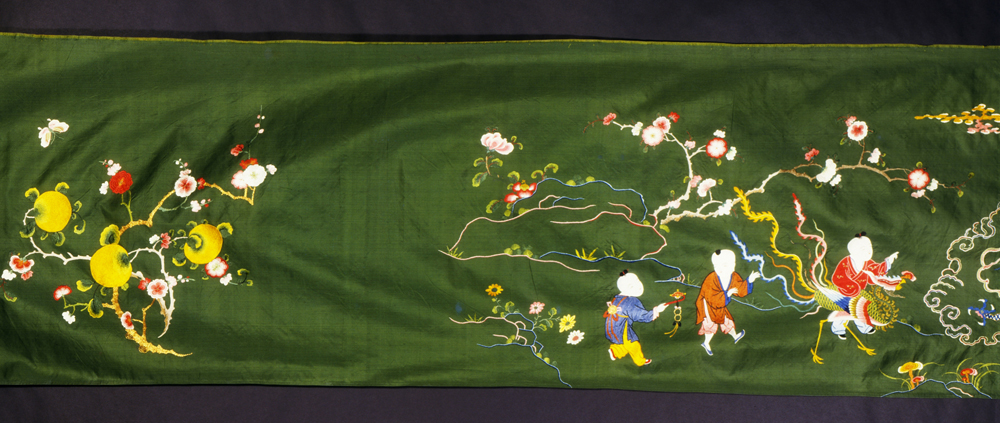

The bed was the symbolic and actual location of procreation, of the woman’s main role of providing male heirs for the ancestral line (fig. 9). In Chinese history, the birth of sons was particularly wished for; a woman’s position within her husband’s family might become vulnerable if she was unable to do this. As procreation was perhaps the single most important form of family production, great care was taken in the construction and placement of the bed. KlassRuitenbeek notes that in the Ming dynasty carpenter’s manual, the Lu Ban jing (Manuscript of Lu Ban), it is the only domestic object with specific construction measurements.41 These measurements were dictated by cosmological considerations that determined the auspicious directions within the house as a whole. The manual also included a long list of auspicious dates for installing the bed and hanging its curtains. Popularly printed in this period, such manuals were not intended for the carpenter, but for the owner of a new house as a guide to supervision of building and labour.42 Clearly, the bed had enormous symbolic significance; its construction, placement and decoration was influenced by elements of ritual and magic. In turn, these elements might affect the lives of those who used it. If such an object was indeed carefully chosen and prepared for the bedroom, it is not inconceivable that its furnishings were also subject to the same rationale. These objects must have had a function beyond decoration or comfort; personal hopes and aspirations were simultaneously invested in them, and possibly even affected by them.
An afterlife in the tomb
Domestic messages relating to procreation were more commonly found in the woman’s quarters and as such, these messages were also associated with femininity. Evidence of this can be found in tombs; a textile buried with the principle wife of the Wanli Emperor (r. 1576–1620) was decorated with the motif of the ‘Hundred Boys’, expressing the wish for many sons.43 This was a message, and therefore an object, which was associated with a woman and not a man. Items which were buried with men during the Ming dynasty were related to their trade: scholars’ tools; doctors’ implements; soldiers’ arms.44 Objects which were placed in the male tomb and part of the house did not on the whole include objects with an interior domestic message; his tomb and his part of the house prioritised a public life. Yet while the V&A pillow might have a strong association with the females by virtue of its iconography and placement, the message of procreation that it might carry was pertinent to both genders. The production of sons was essential to the continuation of the family lineage. Additionally, both men and women actually used pillows and there is no indication that pillows found in tombs are located in a gender-specific way. As a small and light object, the pillow could be easily transported to different parts of the house – to a scholar’s couch for example. Therefore in terms of its usage as opposed to its powers of representation, the pillow may not necessarily belong solely to the bedroom. Indeed a pillow must be an object with multiple functions and meanings, if it was ultimately used in the grave.
In Chinese popular culture, the head of the deceased was thought to be the most important place within the grave.45 This places a pillow in an extremely strategic position. Wealthy Chinese buried their dead with all the objects and food that they would need for comfort in the afterlife, a practice which began during the late Warring States period and developed during the Han dynasty. In later periods, some objects, such as large and expensive pieces of furniture were made in miniature model form and placed around the coffin. Other smaller items, mainly textiles and crockery, which were used while the person was alive, were interred as evidence of the deceased’s daily life. Pillows fall into this latter category, as they were not made specifically and solely for use in the grave.46 As relatively luxurious objects, only wealthy families would have owned and used ceramic pillows; they can therefore be understood as desirable status symbols. Sometimes exquisitely beautiful and highly crafted objects, a ceramic pillow would certainly have been a decorative addition to the tomb. Objects such as this were used to glorify the deceased, and to demonstrate individual wealth, status and success to the ancestors. The iconography of a pillow might also impart visual testimony about the life of the deceased. In the case of the V&A pillow, it refers to the suitable female sexual and reproductive role in the Chinese family and within the bedroom. It may have been used to demonstrate success in fulfilment of this familial role.
Other iconographic elements of the V&A pillow attest to the status and life of the deceased; the jewellery, fan and dog are each clear symbols of wealth. Owning a pet was one of the more fashionable pleasure pursuits during the later Ming dynasty.47 Historian Timothy Brook argues that there was a rise in conspicuous consumption during this period, in which luxury, and representations of luxury became popular.48 Although images of dogs are not commonplace in Chinese media, this could explain the meaning of its depiction on the V&A pillow. This female figure is therefore likely to represent a secular woman of middle to upper class status. Imagery and representations of women, particularly servants and singing girls, were often found in the tomb as markers of social prestige. Stoneware figurines were commonly made for the tomb in order to serve the deceased in the afterlife. They were not intended to be individual portraits, however, but generic representations of people.49 The V&A pillow could be just such a representation. Certainly it would fit into a larger context of female representation in the grave, as another object which might be symbolic of personal and social status.
Conclusion
The V&A pillow evidently had multiple meanings within the bedroom and its primary message must be related to its function in life. However, this should not negate any possibilities of significance and meaning within the grave. The object’s entire life cycle must be analysed as a whole, as it is possible that it was manufactured with the afterlife in mind. The ownership of a pillow, and the representation of luxurious accessories on it,attest to the person’s status in life and in death. As a reminder of the female role within the family, the pillow may be a prompt for the dreamer in the hope of producing male heirs. In the tomb this may have demonstrated success and worth to the ancestors in the fulfilment of this role. The physical significance of the object in life and in death was achieved through its close proximity to the body; this object was a visual stimulant in the bedroom, a vehicle for dreams, and a support for the head in life, and in death.
Endnotes
-
Vainker, S. J. Chinese Pottery and Porcelain: From Prehistory to the Present. London: British Museum Press, 1991: 166. ↩︎
-
Medley, Margaret. The Chinese Potter: A Practical History of Chinese Ceramics. Oxford: Phaidon Press, 1980: 207. ↩︎
-
Wilkinson, Liz. ‘Collecting Korean Art at the Victoria and Albert Museum 1888–1938’. Journal of the History of Collections 15 (2003): 241–256. ↩︎
-
Victoria and Albert Museum acquisition file: S. M. Franck & Co. Ltd, MA/1/F1203./2. ↩︎
-
Pierson, Stacey. Collectors, Collections and Museums: The Field of Chinese Ceramics in Britain 1560–1960. Bern: Peter Lang AG, 2007: 82. ↩︎
-
‘Tombs of the Sui and Tang Dynasties at Fengxiang of Shaanxi province: The Excavation Report 1983–1990’. Kaogu. Accessed December 12, 2009. https://www.kaogu.cn. This report states that ‘pillows in most of coffins are untraceable, with the exception of three tombs: a tri-colour glazed pillow… a brick pillow…and a tile pillow’. Clearly, pillows are an ordinary find. ↩︎
-
Paine, Jr., Robert Treat. ‘Chinese Ceramic Pillows: From Collections in Boston and Vicinity’. Far Eastern Ceramic Bulletin 3 (1955): 8. ↩︎
-
Chinese Ceramic Pillows From Yeung Wing Tak Collection. Osaka: The Museum of Oriental Ceramics, 1984: 16. This comprehensive source states that it has so far been impossible to confidently determine the use of pillows. The range of possible uses that are listed indicate this: ‘1) funerary models, 2) arm-rests, 3) “pulse” pillows [support during medical examinations], 4) “sleeve” pillows, 5) neck-rests’. ↩︎
-
Vainker, S. J. Chinese Pottery and Porcelain: From Prehistory to the Present. London: British Museum Press, 1991: 115–116. ↩︎
-
Paine, Jr., Robert Treat. ‘Chinese Ceramic Pillows: From Collections in Boston and Vicinity’. Far Eastern Ceramic Bulletin 3 (1955): 2. ↩︎
-
Mino, Yutaka. Freedom of Clay and Brush through Seven Centuries in Northern China: Tz’u-chou Type Wares 960–1600 A.D. Indianapolis: Indianapolis Museum of Art, 1980: 224. ↩︎
-
Kerr, Rose.ed. Chinese Art and Design. London: V&A Publications, 1991: 48. ↩︎
-
GaoLian. ‘Eight Discourses on the Art of Living’. Chapin, Helen B. trans.; Paine, Jr., Robert Treat. ‘Chinese Ceramic Pillows: From Collections in Boston and Vicinity’. Far Eastern Ceramic Bulletin 3 (1955): 9–10. ↩︎
-
Ibid: 11. ↩︎
-
Ko, Dorothy. Teachers of the Inner Chambers: Women and Culture in Seventeenth-Century China. California: Stanford University Press, 1994: 83–87. ↩︎
-
Needham, Joseph. Science and Civilisation in China, Vol. VII, Part II: General Conclusions and Reflections. Cambridge, 2004: 85. ↩︎
-
Bossler, Beverly. ‘Final Instructions by Yang Jisheng’. In Under Confucian Eyes: Writings on Gender in Chinese History, edited by Mann, Susan, and Yu-Yin Cheng. California: California Press, 2001: 119. ↩︎
-
Yang Jisheng ‘Final Instructions’. In Under Confucian Eyes: Writings on Gender in Chinese History, edited by Mann, Susan, and Yu-Yin Cheng. California: California Press, 2001: 127. ↩︎
-
Handler, Sarah. Ming Furniture in the Light of Chinese Architecture. Berkeley: Ten Speed Press, 2004: 61. ↩︎
-
Ibid: 61. ↩︎
-
Ko, Dorothy. Every Step a Lotus: Shoes for Bound Feet. California: University of California Press, 2001: 50. ↩︎
-
Li Yu in Handler, Sarah. Austere Luminosity of Chinese Classical Furniture. California: University of California Press, 2001: 146. ↩︎
-
Bertholet, Ferry M. Concubines and Courtesans: Women in Chinese Erotic Art. Ferry M. Bertholet Collection. Brussels: Mercatorfonds, 2010: 108–110. ↩︎
-
Gillman, Derek. ‘Ming and Qing Ivories: Figure Carving’. In Chinese Ivories from the Shang to the Qing, edited by William Watson. An exhibition organised by the Oriental Ceramic Society and the British Museum, May 24 to August 19, 1984. London: British Museum Press, 1984: 41–43. ↩︎
-
Clunas, Craig. Empire of Great Brightness: Visual and Material Cultures of Ming China 1368–1644. London: Reaktion Books, 2007: 158. ↩︎
-
vanGulik, R. H. Sexual Life in Ancient China: A Preliminary Survey of Chinese Sex and Society from ca. 1500 B.C. till 1644 A.D. Netherlands: Koninklijke Brill NV, 2003: 268. ↩︎
-
Handler, Sarah. Ming Furniture in the Light of Chinese Architecture. Berkeley: Ten Speed Press, 2004: 133. ↩︎
-
Fong, Grace S. Herself an Author: Gender, Agency and Writing in Late Imperial China. Honolulu: University of Hawai’i Press, 2008: 78. ↩︎
-
Fong, Grace S. Herself an Author: Gender, Agency and Writing in Late Imperial China. Honolulu: University of Hawai’i Press, 2008: 78. ↩︎
-
Bartholomew, TereseTse. Hidden Meanings in Chinese Art. San Francisco: Asian Art Museum of San Francisco, 2006: 53 ↩︎
-
Cizhou ware pillow. Jin dynasty, twelfth century. British Museum inv no Franks.2440.e. Accessed 24 November, 2009 ↩︎
-
Fernald, Helen E. ‘Chinese Mortuary Pillows in the Royal Ontario Museum’. Far Eastern Ceramic Bulletin 1 (1952): 2. ↩︎
-
Handler, Sarah. Austere Luminosity of Chinese Classical Furniture. California: University of California Press, 2001: 154–155. ↩︎
-
Vainker, S. J. Chinese Pottery and Porcelain: From Prehistory to the Present. London: British Museum Press, 1991: 117. ↩︎
-
Clunas, Craig. Superfluous Things. Cambridge: Polity Press, 1991: 56. ↩︎
-
Valenstein, Suzanne G. A Handbook of Chinese Ceramics. New York: The Metropolitan Museum of Art, 1989: 112. ↩︎
-
Fernald, Helen E. ‘Chinese Mortuary Pillows in the Royal Ontario Museum’. Far Eastern Ceramic Bulletin 1 (1952): 7–8. ↩︎
-
Chinese Ceramic Pillows From Yeung Wing Tak Collection. Osaka: The Museum of Oriental Ceramics, 1984: 18. ↩︎
-
Handler, Sarah. Austere Luminosity of Chinese Classical Furniture. California: University of California Press, 2001: 148–150. ↩︎
-
Silk Embroidered Cloth, about 1800–1900. Museum no. T.26-1952. Accessed November 15, 2009. ↩︎
-
Ruitenbeek, Klass. Carpentry and Building in Late Imperial China: A Study of the Fifteenth-Century Carpenter’s Manual Lu Ban jing. Leiden: E. J. Brill, 1993: 35. ↩︎
-
Ledderose, Lothar. Ten Thousand Things: Module and Mass Production in Chinese Art. New Jersey: Princeton University Press, 2000: 134–137. ↩︎
-
Clunas, Craig. Superfluous Things. Cambridge: Polity Press, 1991: 56. ↩︎
-
Harrison-Hall, Jessica. Ming Ceramics in the British Museum. London: British Museum Press, 2001: 45. ↩︎
-
Ibid: 46. ↩︎
-
Fernald, Helen E. ‘Chinese Mortuary Pillows in the Royal Ontario Museum’. Far Eastern Ceramic Bulletin 1 (1952): 1–3. ↩︎
-
Harrison-Hall, Jessica. Ming Ceramics in the British Museum. London: British Museum Press, 2001: 37. ↩︎
-
Brook, Timothy. The Confusions of Pleasure: Commerce and Culture in Ming China. California: California Press, 1998: 1–7. ↩︎
-
Harrison-Hall, Jessica. Ming Ceramics in the British Museum. London: British Museum Press, 2001: 544–545. ↩︎
